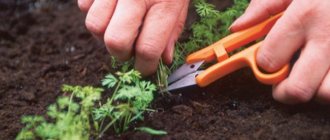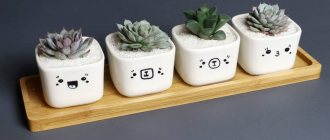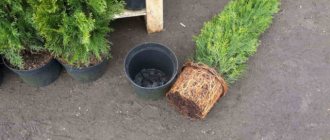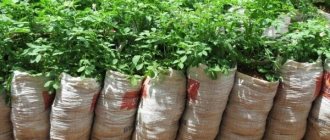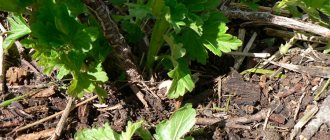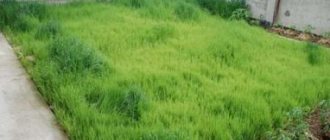Have you decided to transform your interior? Please note that today designers are concerned not only with how to renovate and furnish a room. No less important is the ability to decorate it with furniture and decorative elements so that it becomes elegant and stylish, filled with an atmosphere of comfort and individuality. Among various decorative finds, modern designers like to use special indoor plants - succulents. With their help, you can transform your interior yourself, without turning to a designer. Having learned about the propagation of succulents and the rules for caring for them, you will understand that these undemanding and original plants must be in your home.
What's so attractive about succulents?
Succulent garden
The name succulents, translated from Latin as “succulent”, was given to these plants due to their ability to store moisture for future use in their trunks and leaves. Therefore, they do not require special care and do not require frequent watering.
The variety of succulents is impressive. Tiny that can be grown in test tubes, and impressive in size, they look good in a home conservatory or just on a windowsill. Succulents stand out for their bizarre shape, surprising with the unexpected color of their leaves and unusual flowering.
It is believed that an indoor succulent shares useful energy with a person. It is no coincidence that they are recommended to be placed near a computer monitor; they have a beneficial effect on humans, some types have a healing effect.
Many people remember aloe; this is one of the varieties of succulents that our grandmothers considered mandatory to have on the windowsill. It is recommended to have a fat tree or “money tree” in your apartment or office to ensure financial well-being.
Some of the most popular succulents are also “living stone” and sedum, agave and various types of crassula, milkweed, echeveria and many other flowers.
Read more about Indoor succulents - varieties, care features
Let's find out in more detail how exotic indoor succulents are bred using leaves, plant cuttings or its seeds.
Reproduction
There are three common ways to propagate succulents.
Leaves
It is very easy to propagate succulents using leaves, and this method is the least stressful for the plant itself. Some varieties even shed their leaves themselves, ready to reproduce. In this case, the discarded fragment can simply be inserted into the ground, or even into the same pot where the adult succulent grows. The soil must be well watered and loosened.
In about a couple of weeks, the leaves will sprout roots, and they can be planted in separate pots. The leaf itself should be taken strong, healthy, without injury.
It must be cut off with a sharp tool, and not torn off or broken off.
Sometimes a succulent begins the reproduction process on its own. The dropped leaf takes root in the soil and begins to form roots. It is important to track this process in time and plant the baby further away so that the root systems of both plants do not intertwine. Some succulents have quite large leaf sizes, so you don’t have to use a whole leaf, but only part of it. The cut will first have to be dried for several days, and then deepened one centimeter into a well-loosened substrate.
Using a propagation sheet
To start the type of plant you like, a leaf is enough. Propagation by leaves is a fairly simple and affordable method.
It is necessary to carefully consider the choice of leaf intended for propagation. It should be a strong, healthy leaf, without damage. You should not tear off or break off the leaf; to propagate it, you need to cut it off with a sharp knife, without leaving parts of it on the plant.
The cut leaf should not be placed in water; on the contrary, it must be kept in the air for a day or two so that the leaf dries out somewhat. The leaf needs to be dried on the surface of the soil in which it will grow. You don’t need to do anything special for rooting, you just need to turn the cut of the leaf towards the soil. Everything else will happen without our actions, the leaf will take root on its own!
Video “Propagation of succulents by leaves”
Features of cuttings
There are several strengths of cuttings that set it apart from other types of propagation:
- Speed. Propagation by cuttings occurs much faster than planting leaves or sowing seeds.
- Rooting of succulents can be done both in water and in open ground - at the discretion of the gardener.
- The new plant takes root faster and gets sick less often.
The main disadvantage of this breeding method is the damage caused to the mother succulent. An open wound from the cutting can become a target for pests and diseases, so the plant should be carefully monitored after the cutting is separated.
Cuttings of succulents
Another equally popular and simple method of propagating these exotic plants is cuttings.
The cuttings are also cut with a sharp knife and left to dry for a couple of days. You should definitely pay attention to the plant that gave the cutting. The resulting cut should be sprinkled with coal, which was previously crushed. In this case, before processing, you need to inspect the cut. If the plant is a species that secretes milky sap, the cut is first washed and then treated with charcoal.
Propagation by cuttings is a longer process. You can plant a cutting in the ground only after it has roots.
About rooting cuttings - more details
To root a succulent cutting, you can place it in a year or in a sand mixture. This method is the most suitable for cuttings of different types of euphorbia and crassula.
Rooting in water
Place the cutting in a container with clean, settled water (you can take boiled or distilled water), making sure that its lower part with the cut does not touch the bottom. At room temperature, the cuttings take root within 2-3 weeks. To create more favorable conditions, you can create greenhouse conditions for the plant. To do this, simply cover it with a clean and transparent plastic bag.
Subtleties of rooting in water:
- Treating the cutting with a growth stimulant before immersing it in liquid will make the process more effective.
- The container with the cuttings should be kept in a well-lit place at room temperature, adding water as necessary.
- If the cut rots, the cutting should be cut off and placed again in a container with clean water, after drying and treating with a growth stimulator.
Rooting in the sand
Sand mixture is usually used for rooting sansevieria. A cutting treated with a strengthening compound (Epin, Kornevin) is placed in prepared sand (sifted and fried in the oven or in a frying pan), then watered with warm water.
There is no need to deepen the cutting too much. 1.5 - 2.5 cm in depth is optimal for the plant.
During the process of rooting in sand, the cuttings are also kept in a warm and bright place.
Video “Propagation of succulents by cuttings”
Propagation of succulents by cuttings
Using a sharp knife or scissors, separate a cutting of approximately 8-10 cm from the mother plant. Remove the lower leaves from the cutting so that 2-3 centimeters can be buried in the soil. It is advisable to plant after a couple of days so that the cut areas dry out. Then bury the cuttings almost halfway into the soil. Do not water immediately and, of course, do not expose to the sun. You need a bright place without direct sunlight. It will be possible to place it on the sunny side (if it is a desert succulent or from arid sunny areas) after 2-3 weeks, by which time roots will have already formed. The first watering after planting can be done in 3-4 days, a little at the edge of the pot. The container for planting should be small, and not large enough, so that the soil in it dries out quickly.
Before cutting the cutting, carefully inspect the plant: if you find pests on it, you must first treat the mother plant with a pest control drug, otherwise the cutting may not take root and wither. Do not forget that the tool (scissors, knife) must be clean, and it is advisable to disinfect the blade. Preparing cuttings for planting.
Propagation by seeds
Succulents can be grown from seeds. To do this, you will need soil consisting of fried sand and earth. In containers, the prepared mixture is covered with a thin sand layer (no more than 2 mm in thickness). The seeds are first dipped in a weak solution of potassium permanganate and left for 24 hours. The seeds treated in this way are placed in a thin layer of sand, which is spilled with the same solution before laying out. The container is covered with polyethylene, creating a “mini-greenhouse”. It is kept in a warm and bright place until sprouts appear. The germination period for different species ranges from 2 to 14 days. Diving can be done no earlier than a month after the sprouts appear. But the final transplant is possible only later; at least 6 months must pass before that.
Seed propagation
For seed propagation, fresh seeds are best suited, which need to be pre-washed and sown with a peat-sand mixture. The planting substrate must be sterilized in the oven. The planting container must have high-quality drainage holes and a drainage layer.
To saturate the soil substrate with moisture, you need to place the container with the crops in a pan of water . The temperature before emergence should be approximately 22-24°C. The average time required for seedlings to emerge is two to three weeks, but may vary depending on the quality of the seed and the type of plant being propagated. The emerging seedlings can be transplanted after about six months or a year.
Planting succulents
To ensure the successful development of the plant, you need to follow simple planting rules.
Choosing a pot
Planting fancy flowers starts with deciding which succulent pot will work best. When choosing a container for planting, it is necessary to determine how the flower is supposed to be grown, whether it will be a single planting or a composition of flowers will be created in a pot. In this regard, a more or less spacious pot is selected. Planting in a flat flower container is also popular. You should not choose a pot that is too large. In this case, the growth of the plant will be slowed down: the succulents first “master” the planting pot with their roots and only then use the energy to develop the upper, above-ground part of the plant.
When choosing a container for planting, the gardener independently gives preference to the material from which it is made (plastic or clay), as well as the shape of the pot. A mandatory requirement for any planting container is the presence of a drainage hole in the bottom of the pot.
Video “Choosing a pot for succulents”
Soil preparation
The next step is to prepare succulent-friendly soil. Flower and garden stores sell soil for indoor succulents. In addition to this soil, it is necessary to prepare river sand and expanded clay for drainage.
Fill the pot in the following sequence: first layer - drainage, 2nd layer - wet soil mixture, 3-1 layer - sand.
Landing
The succulent is planted in soil mixture. The sprout is carefully placed in the pot without damaging the roots of the flower. The soil mixture should cover the roots up to the root collar, which should be in the sand layer. This will keep the plant from rotting.
Adaptation
An important moment in the life of a plant is the adaptation period and care after reproduction. For 1-1.5 weeks, the plant is protected from direct sunlight to avoid burns and is not watered. The moisture content of the soil mixture will be sufficient, but its excess can lead to rotting.
Video “Soil for succulents”
Propagation of succulents by leaves
The leaves should be grown (it is better to take them from the lower rows), without damage and without signs of disease or pests. Taking the leaf at the base, gently shake it from side to side and it will separate from the mother plant without breaking. It is better to let the leaves, as well as stem cuttings, weather for a day or two so that possible damage can heal. You can spread it over the surface of the substrate, you can slightly deepen the base of the leaf - and this way it will take root.
Echeveria propagated by leaf cuttings.
Propagation of succulents by dividing the bush
Well, this shouldn't be difficult. The bush of a succulent plant is divided in the same way as the bush of any other plant. Carefully inspect your plant: are there any other shoots or trunks extending into the soil besides the main one. If you see that the bush can be divided, take it out of the pot, shake off the soil thoroughly and see if the part of the plant that you want to separate has roots. If there is one, feel free to divide the root; you can use a knife or scissors. If there are no roots, divide them anyway (it’s not in vain that you dug up the plant): the roots can be grown (see point 1). Select a pot based on the volume of the root system and the size of the division; do not try to take a pot “for growth”: the root system will not soon be able to cover the volume of soil, and this is fraught with rotting.
Dividing a haworthia bush.
Propagation of succulents by seeds
Seed propagation of succulents is a rather labor-intensive process and not a quick result. Most often, breeders and professionals resort to it, but it’s worth a try, since, despite the difficulties, the process is fascinating. The soil must be sterile, moisture-permeable and breathable so that water does not linger in it. There must be a good drainage system: drain holes and a good layer of expanded clay or material used as drainage. It is better to sow in greenhouses with a transparent lid or disposable plastic containers.
Succulent seeds come in different sizes. If the size of the seeds allows, then it is advisable to disinfect them for several hours in a manganese solution before sowing (the water should be well pink, but not bright pink). Dust-like seeds and the size of a poppy seed are sown superficially. After sowing, the surface of the soil is moistened with a spray bottle; after half an hour, you can cover it with a transparent lid and place it in a bright (but not yet sunny) place. Crops will need to be ventilated every day. Moisten the soil only when it dries (but does not dry out into dust!). Gradually accustom the seedlings to the sun (if they are sun-loving succulents). There are many succulent plants, so carefully read the recommendations for sowing your particular plant. There may be nuances that need to be paid attention to.
Cacti from seeds.
Soil for succulents
The main requirement for soil intended for succulent plants is that it must be loose! That is, water should not linger in it for a long time, over-wetting the plant. It must contain sand, ideally coarse washed river sand. You can add broken brick, small clean pebbles, zeolite, perlite, broken shell rock to the soil composition, using turf soil as a basis. If you don’t have the opportunity or desire to make a soil mixture yourself, use a ready-made store-bought one. It is a must have for cacti and succulents. If there is not enough sand in it, buy sand separately and add it.
Cuttings of succulent plants.
If you liked the article “Propagation of succulents”, you may find the article Houseplants - Succulents useful.
Caring for Succulents
Succulents are an undemanding houseplant. But you can’t do without following the basic rules of care.
- Watering
These indoor flowers do not need abundant watering. The frequency of watering depends on the time of year. In winter, plants are watered less often; succulents at room temperature are watered no more often, 1-2 times a month. Starting in spring, watering becomes more frequent: every 7-10 days.
- Fertilizer
Succulents respond well to weak solutions of phosphorus-potassium fertilizers without nitrogen or with a minimal amount of it. Frequent application of fertilizers - 1-2 times a month.
The industry also offers special complex fertilizers for succulents. When using them, specific instructions for use must be followed.
By following these simple rules for propagating, planting and caring for flowers, you can do more than just start succulents at home. An original composition of beautiful and unusual plants will become a real interior decoration.
Further care
Succulents are unpretentious plants, so even an amateur grower can handle caring for them at home. Irrigation of the soil should be regular, but not abundant. The amount and frequency of water use are determined depending on what time of year it is. In winter, if the succulent grows at normal room temperature, watering once or twice a month will be enough. Approximately from March, from the beginning of the growing season, irrigation is carried out once a week or 10 days.
When growing a succulent at home, it is certainly worth feeding the plant, but in small doses. Fertilizers are applied once a month or once every two weeks. It is recommended to choose complex formulations containing potassium and phosphorus, but practically free of nitrogen. The solution should be weak. Fertilizing is carried out according to the instructions.
While the young shoots are not yet strong, caring for them should be slightly different from usual. The optimal temperature in this situation ranges from 22 to 30 degrees Celsius. The difference between winter and summer temperatures should be smooth.
Lighting should be plentiful, even direct rays are allowed, but at midday, young shoots should be shaded for some period.
What are succulents
Almost all representatives of this group are endowed with succulent, literally filled with liquid stems and leaves. Such reserves are conceived by nature for the purpose of survival, since the living conditions of plants are not at all easy. Almost all of them grow in desert areas, where it is very difficult to obtain water.
To adapt to conditions of lack of water, succulents are endowed with the following qualities aimed at reducing the evaporation of liquid and its reserve:
- The stem and leaves are covered with a waxy coating or densely pubescent.
- The leaves are replaced by spines, through which evaporation does not occur.
- Many succulents have a ribbed stem that expands when water enters it, thus increasing its storage capacity.
Succulents - crops native to the desert
- Often the leaves have a rounded shape, which reduces the area of evaporation.
- During the day, the plant “does not breathe.” Gas exchange occurs at night, when the air temperature drops and humidity rises.
- The leaves are shaped like a trough, allowing moisture to flow down to the roots.
- In order to protect from the burning sun, all parts of the crop are light in color and are capable of producing protective red and brown pigments.
- Most of the plant is hidden in the ground.
Succulents also have adaptations for protection from natural enemies: insects, birds and animals. For example, thorns, poisonous or simply very bitter juice. Some of them “hide”, imitating the surrounding stones (lithops), while the leaves of others “scare” by resembling the open mouth of an animal (fuakaria).
According to the botanical classification, all succulents are divided into 2 subgroups:
- Stem plants are able to retain moisture in thick stems. These include cacti, .
- Leafy - store water in the fleshy leaves. Representatives of hot countries include Lithops, Echeveria, and Haworthia. In temperate climates you can find sedum and young plants in nature.
All of the listed succulents adapt perfectly to indoor conditions, so amateurs are happy to grow them on their windowsills.
Best way to plant
If you are using leaves, place them on the surface of the soil , making sure that their ends do not touch the soil. Water whenever the soil becomes dry. You can use a sprayer to maintain moisture in the upper layers of the soil.
Some gardeners recommend placing the cut end of the leaf in the soil, but this may cause rot.
Unlike leaves, cuttings need to be planted in soil. Since these are practically mature Succulents, all they need is planting and watering . They will start to grow! Like leaves, cuttings should be watered whenever the soil is dry. This is what the leaves look like laid out on the substrate:
If some of them die , don't worry - more than half will germinate! Some will grow very slowly, while others will have a lot of roots and no leaves at all. Each cutting grows differently, and it is completely normal if it fails to germinate!
As new plants develop, be sure to keep the roots covered with soil, otherwise they will dry out and the flower will stop growing.
In addition to the article, watch an educational video on growing Succulents from leaves:
Most Succulents will take at least a few months to grow into a mature plant, but some take about a year. In general, this is not a quick process , but it works! Try it, and very soon there will be a new addition to your collection of home flowers.
How to separate a sheet
Everything will depend on the type and type of your Succulent . For example, most tender Sedums, as well as some Echeverias, can be propagated by either leaf or cuttings. On the other hand, Aeoniums are propagated only from apical cuttings. This is why you cannot breed them using leaves.
In other words, all varieties of Succulents are different, so if you don't know what works for you, just experiment! And in order to separate the leaf, simply twist it from the stem. The main thing is to make sure that there is nothing left on the stem. In fact, it's best to pull the leaf a little .
If you damage the leaf and part of it remains on the stem, most likely nothing will work out. Once done correctly, you will be able to see a clear outline at the base of the separated leaf.



